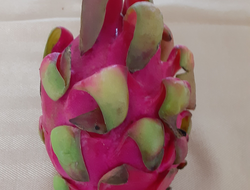Dragon fruit and health
Published: November 19, 2020
Dragon fruit has been hailed as a highly nutritious fruit which supports a range of health benefits. Google “dragon fruit” and you will be provided with many links which extol this fruit's health benefits.
However, is dragon fruit any better for you than other fruit?
What is dragon fruit?
Dragon fruit, which is also known as pitaya and sometimes strawberry pear, has a leathery skin with scaly spikes.
The skin and flesh of the fruit vary depending on the variety.
Pitaya blanca (Hylocereus undatus) is pink-skinned with white flesh, pitaya roja (Hylocereus costaricensis) has red skin and red flesh, while pitaya amarilla (Hylocereus meglanthus) has yellow skin and white flesh.
Pitaya (also pitahaya) is the fruit of the cactus (Cactaceae hylocereus) and typically weigh between 150 -600 grams. The texture of the flesh is similar to kiwi fruit and contains black crunchy seeds which can be dried and stored.
When ripe, dragon fruits are slightly soft. When buying dragon fruit select fruits with unblemished skins. If fruits are hard they will ripen on the counter.To eat wash, cut into sections, and peel and discard the skin.
Dragon fruit can also be grilled.
Raw dragon fruit can be used in cocktails, desserts, salads, smoothies and in some fish dishes. Dragon fruit is also used to flavour and colour juices and alcoholic beverages. Flowers of the plant can also be eaten or steeped as tea.
Health benefit claims
A range of health benefit claims have been made regarding consumption of dragon fruit and/or dragon fruit extracts. Most of these claims concern antioxidants contained in dragon fruit.
Antioxidants act as free radical scavengers and neutralise free radicals protecting molecules within your body from oxidation..link to the full article to learn more.

